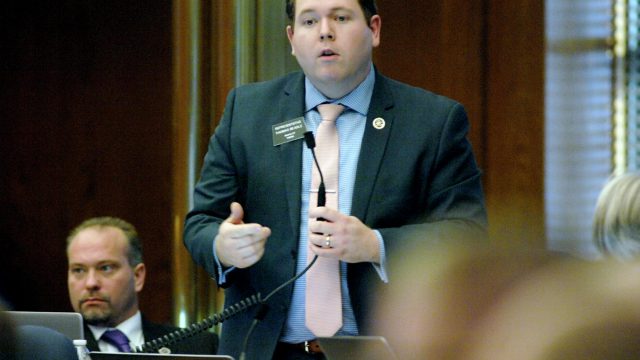Audit: North Dakota’s Use of Open Source Textbooks Has Saved North Dakota Students a Lot of Money

Rep. Thomas Beadle, R-Fargo, urges other House members to vote in favor of HB1386 during floor debate at the state Capitol in Bismarck on 2-10-2017. The bill prohibiting discrimination on the basis of sexual orientation failed 22-69.
For generations now the cost of higher education has been out of control. This isn’t exactly news to you, I’m sure, but it may surprise you to know that the cost of textbooks has grown even faster than the rapid increase in tuition costs.
Check out this graph from a recent report from the North Dakota State Auditor’s Office (full report below):

Those growth lines, both for tuition and textbooks, are a point of frustration. Despite armies of politicians implementing policy aimed at making higher education more affordable the costs just keep climbing at a rate far above what Americans pay for things like food and shelter and transportation.
Mostly what the politicians have done is make it easier to borrow money to pay for these growing costs. Which, in turn, has led us to a troubling ballooning of student loan debt in our society. In the North Dakota University Sytem, as of 2015, the average student is left with about $27,000 in debt.
But I digress.
The point of my post today is to point to a policy, the seeds of which lay in North Dakota’s 2013 legislative session, which has actually bent the cost curve of attending the public universities in our state. House Concurrent Resolution 3009, introduced by Rep. Tom Beadle (R-Fargo), initiated a study into the use of open source textbooks. In later sessions the Legislature funded grants aimed at facilitating the adoption of open source course materials.
Today the use of those materials has grown significantly, according to a new report from State Auditor Josh Gallion, and it’s saving students big.
You can read the full audit report below, but allow me to share a few selected graphs which illustrate what I’m talking about.
First, the growth in the use of these materials has been significant since the Legislature acted. As of the Fall 2017 semester, about 240 courses offered at our state universities are using the materials, and that’s impacting about 5,600 students:

There’s still a lot of opportunity – as a point of reference, consider that the North Dakota University System has around 40,000 students in a given year – but the trend is encouraging.
Even more encouraging is the trend line for cost savings. “The cumulative total for the 7 semesters was 648 OER courses with estimated savings ranging from $1.1 million to $2.4 million, which is approximately 10 to 20 times the initial legislative appropriation for this OER initiative,” the auditor’s office reports:

Again, it’s a rare thing for the cost of anything associated with higher education to go down. Yet this policy has, very quietly, accomplished meaningful cost reductions for one of the most expensive aspects of attending higher education.
That’s a big deal, and there is still room to grow. Not every course offered in our state universities can use open source materials, unfortunately, but there are still plenty which can. Let’s hope, for the sake of students and taxpayers alike, this trend continues.
Speaking of the taxpayers, I interviewed Beadle about this policy on Friday, and he said another big opportunity for these open source materials is in the world of K-12 education. Lowering the cost of course materials for our high school and elementary students would meaning significant savings for local school boards. Savings, one would hope, which could impact property taxes.
Here’s my interview with Beadle:
Here’s the full audit report:
[scribd id=393588043 key=key-JezstmZB4QUuOQJQId4B mode=scroll]




